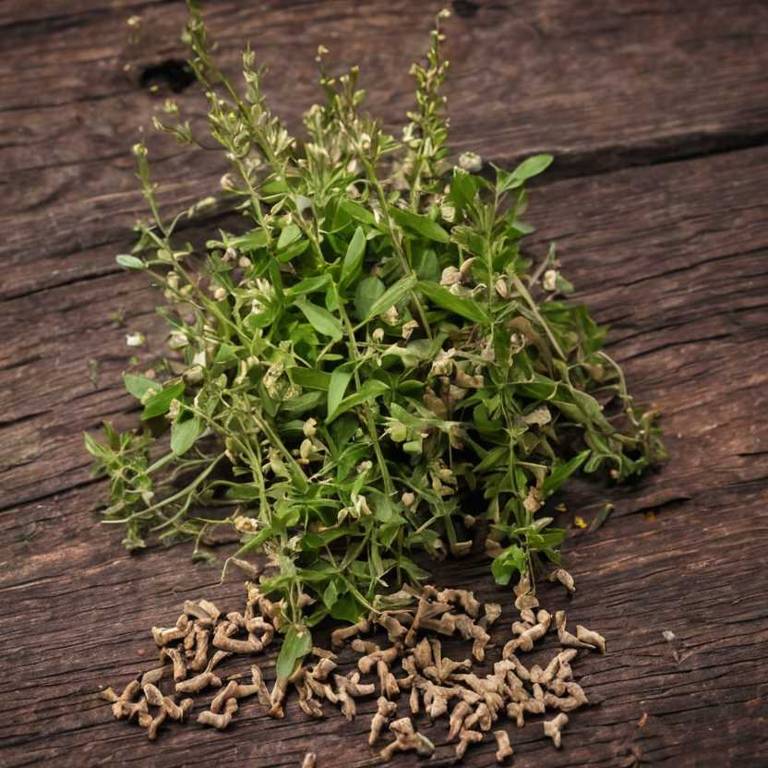By Leen Randell
Updated: Jul 21, 2024
10 Medicinal Constituents Of Polygonum Multiflorum (Fo-Ti)

Polygonum multiflorum has active constituents such as emodin, stilbenes, and flavonoids.
These constituents possess anti-inflammatory, antioxidant, and anti-aging properties. They have been used to improve cardiovascular health by reducing cholesterol and triglyceride levels, as well as to boost immune function.
Additionally, the constituents may help to improve cognitive function and prevent age-related diseases, such as Alzheimer's and dementia, ultimately enhancing the overall quality of life for individuals.
This article explains in details the 10 best active constituents of Polygonum multiflorum .
1. Flavonoids
Polygonum multiflorum flavonoids is a class of bioactive compounds found in the plant.
These flavonoids have been extensively studied for their potential health benefits, including antioxidant, anti-inflammatory, and antiviral properties. They have been shown to scavenge free radicals, protect against cell damage, and modulate immune responses.
Additionally, fo-ti flavonoids have been reported to possess antitumor and anticancer activities, making them a promising area of research in the development of novel therapeutics.
2. Phenolic acids
3. Saponins
Polygonum multiflorum saponins is a type of bioactive compound extracted from the root of the plant.
These saponins have been traditionally used in Chinese medicine for their numerous health benefits, including anti-inflammatory, antioxidant, and cardiovascular protective effects.
The saponins are responsible for the plant's ability to promote blood circulation, reduce blood pressure, and improve overall cardiovascular health, making it a popular herbal remedy in traditional Chinese medicine.
4. Triterpenes
Polygonum multiflorum triterpenes is a type of compound extracted from the plant's roots and stems.
These triterpenes are responsible for many of fo-ti's medicinal properties, including antioxidant and anti-inflammatory effects. They have been shown to exhibit neuroprotective activity, inhibit cancer cell growth, and improve cardiovascular health.
Additionally, triterpenes have been found to possess immunomodulatory and antimicrobial properties, making them a valuable component in traditional Chinese medicine.
5. Resin acids
Polygonum multiflorum resin acids is a type of compound found in the roots and stems of the plant.
It has been traditionally used in Chinese medicine for its perceived health benefits, including anti-inflammatory and antioxidant properties.
Resin acids are composed of various chemical compounds that have been shown to exhibit antimicrobial, antiviral, and antitumor activities, making them a valuable component of fo-ti's therapeutic potential.
6. Glycosides
Polygonum multiflorum glycosides is a type of bioactive compound found in the plant.
These glycosides are composed of flavonoids and saponins, which have been shown to exhibit various biological activities such as antioxidant, anti-inflammatory, and anticoagulant properties.
They are also responsible for the plant's ability to improve blood circulation and lower cholesterol levels, making it a popular ingredient in traditional Chinese medicine.
7. Coumarins
Polygonum multiflorum coumarins is a group of chemical compounds responsible for its medicinal properties.
These compounds are derived from the leaves and stems of the plant, which have been used in traditional Chinese medicine for centuries to treat various ailments such as cardiovascular disease, cancer, and Alzheimer's disease.
Coumarins have been shown to exhibit anti-inflammatory, antioxidant, and anticoagulant activities, making them a valuable component of fo-ti's therapeutic effects.
8. Catechins
Polygonum multiflorum catechins is a type of antioxidant compound found in the leaves and stems of this traditional Chinese herb.
These polyphenolic compounds have been shown to exhibit potent anti-inflammatory, antimicrobial, and anticancer properties.
Research has demonstrated that Polygonum multiflorum catechins may help protect against oxidative stress, improve cardiovascular health, and even exhibit neuroprotective effects, making them a promising area of study in the field of medicinal chemistry.
9. Quercetin
Polygonum multiflorum quercetin is a bioflavonoid compound isolated from the root of the plant.
It has been traditionally used in Chinese medicine to promote vitality and longevity. Quercetin in Polygonum multiflorum has been shown to have antioxidant, anti-inflammatory, and antiviral properties, making it a popular ingredient in dietary supplements and health products aimed at supporting cardiovascular health and immune function.
Its bioavailability is also improved by its combination with other nutrients in the plant extract.
10. Kaempferol
Polygonum multiflorum kaempferol is a flavonoid compound isolated from the roots of this plant.
Kaempferol has been shown to possess various bioactivities, including antioxidant, anti-inflammatory, and antimicrobial properties.
It has also been reported to exhibit cytotoxic activity against certain cancer cells and may be effective in preventing cardiovascular disease by reducing lipid peroxidation and improving blood flow.